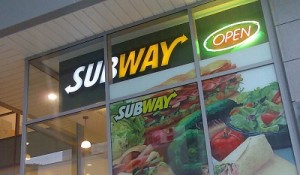The sub sandwich chain has had a smartphone and web presence for quite a while but this will step it up.
Though Subway is far from new to the smartphone ecosystem, it is making its way into a new direction that is meant to provide enhanced transaction methods by way of mobile payments solutions.
They are now working on the launch of new options that will include integration with PayPal.
Karen Webster, the MDP CEO, has been working with the director of global payments and emerging commerce at Subway, Ken Moy, as well as the co-founder of Paydiant, Chris Gardner, in order to help to understand the way that the digital lifestyle and the healthful lifestyle are now coming together and how Subway can use this trend to benefit its customers. Among the solutions that they found was a range of new mobile payments options that include its web presence, its mobile app, and an integration with PayPal.
The goal of these mobile payments and m-commerce options is to make ordering very easy.
 This is only the latest in a much broader strategy to incorporate the use of mobile technology into the Subway customer experience. The focus is to be able to broaden and bring together the various channels through which customers can interact with the brand and its restaurants, for a more complete, convenient, and seamless process.
This is only the latest in a much broader strategy to incorporate the use of mobile technology into the Subway customer experience. The focus is to be able to broaden and bring together the various channels through which customers can interact with the brand and its restaurants, for a more complete, convenient, and seamless process.
According to Moy, “It’s the coming together of the healthy lifestyle Subway is known for with the digital lifestyle that consumers expect.” He went on to say that overall, customers expect that their favorite companies will be able to provide them with a “a beautiful customer and digital experience.” He stated that “we are going to need to be able to be flexible and continue to add on feature-functionality and other services to fulfill that digital promise to our customers.”
The mobile payments options are now being launched at the order.subway.com online experience as well as though its mobile app, so that there will be less friction when customers pay for their orders. PayPal is on Subway’s list of upcoming offerings and this will arrive before the close of the year.
BWild |
February 28, 2014
As smartphone based transactions take off at breakneck speed, everyone is trying to hop aboard.
The speed with which mobile payments services are growing and are becoming accepted have now made it clear to most large banks that if they want to be able to remain relevant into the future, they will need to be able to offer their customers the ability to pay for goods and services through the use of smartphones.
Many telecoms and credit card companies are also hopping on board this massive trend.
Even retailers are starting to come up with their own opportunities to hop onto the mobile payments bandwagon and are coming up with their own unique strategies. As the shift toward smartphones as a platform continues, a growing number of companies from massive international giants to small mobile app development startups are trying to turn themselves into important players in this sector.
As mobile payments adoption becomes more common, the competition for those positions is growing.
In fact, it has already reached the point that solutions providers are trying virtually anything to carve out their share of this market, and to continue clawing to broaden that share. Unfortunately, as this continues to occur at an increasingly rapid rate, it is also causing this particular market to fragment. The technology as a whole is owned by many groups and within each group there is a flood of different players. Every one of them is looking to dominate as opposed to creating a consistent experience overall.
The result has been the development of what David Sear, Weve managing director, called a “mess”. He pointed out that “It is confusing for people and for banks, as well as being costly all round.” He explained that scalability is critical in order to make this market work. While it is currently questionable whether the situation is contributing to bank revenues in any way, it is undoubted that these institutions must hang onto it, regardless, in order to succeed in the future.
This fact makes the future of mobile payments extremely hard to predict. The form of it, at the moment, suggests that it will only continue to become more muddied and complex before it has the ability to improve.
 This is only the latest in a much broader strategy to incorporate the use of mobile technology into the Subway customer experience. The focus is to be able to broaden and bring together the various channels through which customers can interact with the brand and its restaurants, for a more complete, convenient, and seamless process.
This is only the latest in a much broader strategy to incorporate the use of mobile technology into the Subway customer experience. The focus is to be able to broaden and bring together the various channels through which customers can interact with the brand and its restaurants, for a more complete, convenient, and seamless process.

